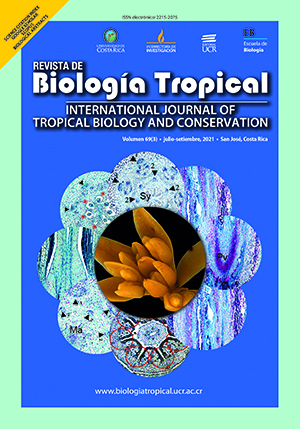Abstract
Introduction: The dynamic of the environmental conditions influences the availability of the food resources for the estuarine organisms, affecting the food consumption of the benthic organism such as the soles, which are essential for establishing and monitoring the environmental quality of these ecosystems. Objective: To determine the trophic habits of three species of the Achiridae family in Buenaventura Bay, Colombian Pacific. Methods: Fish were captured using artisanal trawling. Then, the diet of each species was determined and different trophic indexes were calculated registering differences in alimentary habits among species. Results: It was collected a total of 159 fishes of the genus Achirus, being the most abundant Achirus klunzingeri (98), then Achirus mazatlanus (44) and finally Achirus scutum (17). The diet of A. scutum was based on detritus, the diet of A. mazatlanus was mainly detritus and fish whereas the diet of A. klunzingeri presented a dynamic pattern based mainly on crustaceans and fish. The individuals of Achirus klunzingeri presented differences in the diet between the internal and external area of the estuary, in the internal zone the fish were the main prey while in the external zone were the crustaceans. The species A. klunzingeri and A. mazatlanus presented ingestion of microplastics, mainly elongated and colorless fibers which were present in individuals of all sizes. The dynamic of the trophic habits of A. klunzingeri was related to the environmental variables such as temperature, transparency and dissolved oxygen. For example, these three variables presented negative correlations with the item fishes, and positive for the crustacean category. Conclusions: Despite the generalist nature of the studied species, the environmental conditions, not only influenced the food consumption dynamic, but also determined the presence of microplastics.
##plugins.facebook.comentarios##

This work is licensed under a Creative Commons Attribution 4.0 International License.
Copyright (c) 2021 Revista de Biología Tropical







